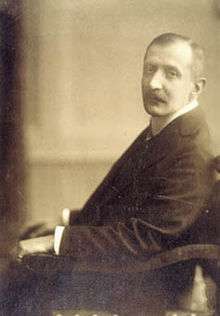György Almásy
György Ede Almásy de Zsadány et Törökszentmiklós (Felsőlendva (now Grad, Slovenia), 11 August 1867 – Graz, 23 September 1933) was a Hungarian Asiologist, traveler, zoologist and ethnographer. His son, László Almásy, was an aviator, Afrologist and soldier.

Life
His father, Ede Almásy, was a founding member of the Hungarian Geographical Society. György Almásy studied for a law doctorate at the University of Graz, as customary for his status in society. After university he worked in Budapest as a civil servant, but after leaving his profession he returned home to manage his estate. He was interested from the beginning in zoology and, within that, ornithology. He published a book with István Chernel as co-editor. His first more serious journey was taken to the Danube delta to study ornithology.
On 3 December 1891 he married Ilona Pittani, by whom he had three children: Györgyike, born in Borostyánkõ on 25 September 1892 and married to Antal Gyömörey de Gyömöre et Teölvár, János (Kőszeg (Güns), 7 March/September 1893 - Borostyánkõ (Bernstein im Burgenland), 21 August 1968), married at Gyuleviz Castle (Zsira) on 1 June 1929 to Princess Mária Róza Alojzia Alexa Paulina Esterházy de Galántha (Eisenstadt/Kis-Marton, 25 January 1900 - Bernstein, Burgenland, 30 November 1971), without issue, and László Almásy.
He first travelled to Asia in 1900 with Rudolf Stummer of Traunfels, his teacher of zoology at the University of Graz. They journeyed through the region of the river Ili, the eastern areas of the Issyk Kul, and the unexplored, third mountain range of the Tien-San. The zoological achievement of their journey was the collection of around 20,000 animals (mostly birds), with many newly discovered species among them. This tour gave him extensive experience, but rather than from his zoological observation, this experience was derived from his vivid ethnographical notations, which are concerned with the everyday life of the Kyrgyz and Kazakh peoples.
Gyüla Prinz took a part in this journey, but due to disagreements with Almásy, their roads soon split and they made independent, but valuable, observations (Prinz's My Journeys in Central Asia give vivid descriptions of the things they saw).
Almásy came home disappointed from his last journey, from this point onwards he lived withdrawn on his land. His journal and letters sent to his wife tell the rest of the story, but these unfortunately have not been published. His knowledge of the Russians and Turks made it possible to better understand and communicate with Russian officials and Kyrgyz tribal chiefs during his travels.
He published a very important article on the teller of the Kyrgyz epic of "Manas" about a farewell meeting between the Kyrgyz hero and king Manas with his two-month-old child, Semetei (the magazine Keleti Szemlé, 1911–12.) It included a Latin transcript of the Kyrgyz-language text of the episode.
Contributions
György Almásy's field work and descriptive writings about them constitute his highest achievement. Later, he primarily made ethnographical and oriental studies; these found readership in the Ethnographical Bulletin and Bernát Munkácsy's journal. His collected works on the Kyrgyz, which the Néprajzi Múzeum holds, have played a part in ethnographical exhibitions.
Works
- Madártani betekintés a román Dobrudzsába (Ornithological investigation into the Romanian Dobruja). Budapest, 1898.
- Utazásom orosz Turkesztánba (My Journey to Russian Turkestan). Budapest, 1903.
- Vándor-utam Ázsia szívébe (My Travels to the Heart of Asia). Budapest, Természettudományi Könyvkiadó-vállalat, 1903.
Literature on him
- Асанов У.А., Джуманазарова А.З., Чоротегин Т.К. Кыргызская наука в лицах: Краткий исторический и био-библиографический свод / Отв. ред. академик У.А.Асанов. - Бишкек: Центр госязыка и энциклопедии, 2002. - 544 стр., илл. - ISBN 5-89750-142-4
External links
- The "other" Almásy (in Hungarian)
- Ethnographical lexicon: György Almásy (in Hungarian)
- György Almásy (1867-1933), Terebess Ázsia e-library (in Hungarian)